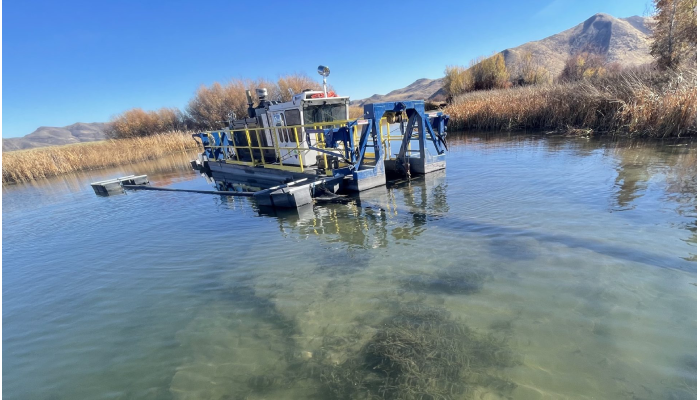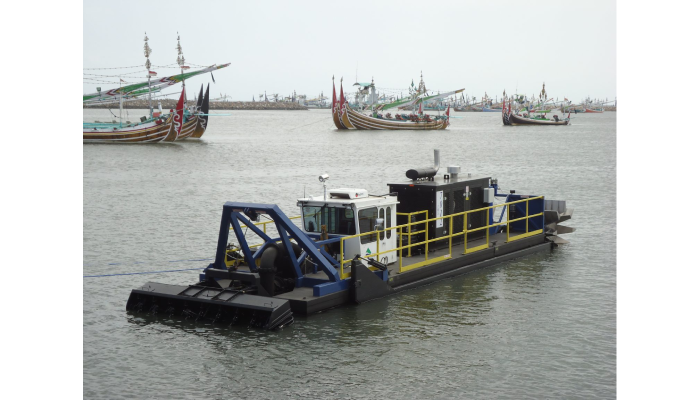Operating a canal dredge safely involves several key steps to protect personnel, equipment, and the environment. First, following international safety standards like ISO and IMO regulations helps ensure operations meet legal requirements. Creating a strong safety culture within the company is important too; everyone must stay alert and feel responsible for spotting risks. Before starting work, teams should perform thorough risk assessments and use proper personal protective gear such as helmets and life jackets. Clear communication on board is vital to avoid accidents, especially near machinery zones. Regular training and emergency drills prepare workers for unexpected situations. Lastly, monitoring environmental conditions helps prevent harmful impacts during dredging activities.
Safety Standards and Regulations for Canal Dredging
Operating a canal dredge safely requires strict adherence to a range of international and local safety standards. Key international frameworks include ISO 9001 for quality management, ISO 14001 for environmental responsibility, and ISO 45001 for occupational health and safety. These standards establish a solid foundation for managing safety risks and environmental impacts. On the maritime side, compliance with the International Safety Management (ISM) Code is essential for managing vessel safety and protecting the marine environment. Dredging vessels must also follow major IMO conventions like SOLAS for life safety, MARPOL for pollution prevention, and COLREG for navigation rules to ensure safe operation and avoid accidents. Vessel security is governed by the ISPS Code, which helps manage threats and unauthorized access, a vital consideration for dredging equipment operating in busy waterways. Beyond international rules, operators must meet all relevant national and local maritime regulations, which can vary depending on the dredging location. This includes ensuring that dredging vessels have proper certifications and up-to-date inspection records as required by regulatory bodies. Maintaining thorough documentation of safety policies, operational procedures, and training records supports compliance verification during audits. Safety protocols should be regularly reviewed and updated to reflect regulatory changes and evolving industry best practices. Coordination with port authorities and other governing agencies is necessary to secure all required permits and operational clearances before starting work. Staying informed about new regulatory developments allows operators to anticipate and incorporate additional safety measures promptly, reducing risks and ensuring smooth project execution.

Building a Strong Safety Culture on Dredging Projects
Creating a strong safety culture on canal dredging projects starts with promoting shared responsibility among all workers. Every team member should feel empowered to identify and report unsafe conditions without hesitation. This openness helps catch risks early and prevents accidents. Safety programs tailored to the specific risks of each project and aligned with company values go beyond mere compliance, making safety a core part of daily work rather than just a set of rules. Open communication is essential; workers need to raise safety concerns without fear of reprisal, ensuring issues are addressed promptly. Leadership engagement at all levels strengthens this culture when supervisors and managers visibly support and participate in safety activities, setting a clear example. Recognizing and rewarding safe behavior motivates everyone to stay vigilant and care for each other’s well-being. Integrating safety discussions into daily routines, such as pre-shift meetings and toolbox talks, keeps safety top of mind and relevant to the tasks at hand. Teamwork plays a key role, where experienced workers mentor newer personnel and share practical knowledge about safe practices. Incident and near-miss reports should be treated as learning opportunities rather than moments to assign blame, encouraging honest reporting and continuous improvement. Clear, accessible safety policies must be maintained so all employees and subcontractors understand expectations and procedures. Finally, regularly assessing the safety culture helps identify gaps and areas for improvement, keeping the project aligned with evolving best practices. For example, a dredging crew that openly discusses near-misses during morning briefings and recognizes safe behavior publicly tends to have fewer accidents and higher morale. Building this culture takes time and consistent effort but is essential to protect lives, equipment, and the environment on every dredging project.
- Promote shared responsibility where every worker can identify and report unsafe conditions.
- Develop safety programs tailored to project risks and company values beyond just compliance.
- Encourage open communication so that safety concerns are addressed without fear of reprisal.
- Engage leadership at all levels to visibly support and participate in safety activities.
- Recognize and reward safe behavior to motivate ongoing vigilance and care.
- Integrate safety discussions into daily routines such as pre-shift meetings and toolbox talks.
- Foster teamwork where experienced workers mentor newer personnel on safe practices.
- Use incident and near-miss reports as learning tools, not for blame assignment.
- Maintain clear safety policies accessible to all employees and subcontractors.
- Conduct regular safety culture assessments to identify areas needing improvement.
Risk Assessment and Hazard Identification Before Dredging
Before starting any canal dredging operation, conducting a thorough risk assessment and hazard identification is essential. Begin with detailed site surveys to uncover underwater dangers such as debris, unexploded ordnance (UXO), or uneven sediment layers that could affect equipment stability or worker safety. Environmental risks must also be evaluated, including water currents, prevailing weather conditions, and the presence of wildlife that could be disturbed or pose hazards. Mechanical risks are a key focus, requiring inspection of dredging equipment for wear, operational limits, and potential failure points. Chemical hazards cannot be overlooked; contaminated sediments or the risk of fuel spills must be identified early to prevent environmental damage and health issues. Human factors play an important role as well, so assess worker fatigue, skill levels, and communication barriers that might compromise safety. All identified risks should be documented clearly along with control measures, assigning responsibility to specific personnel for mitigation. Reviewing historical incident reports from similar projects helps anticipate common hazards, enhancing preparedness. Risk assessments should be dynamic, updated regularly to reflect changing conditions during dredging activities. Including subcontractors in the hazard identification process ensures diverse perspectives and comprehensive coverage. Finally, apply risk rankings to prioritize safety efforts and resource allocation effectively, focusing attention on the most critical hazards first.
Proper Use of Personal Protective Equipment (PPE)
Personal Protective Equipment (PPE) is essential for ensuring the safety of all personnel involved in canal dredging. Workers should be supplied with helmets, gloves, safety glasses, hearing protection, and life jackets specifically designed for dredging tasks. Proper fit and maintenance of PPE are critical; ill-fitting or damaged gear can reduce protection and increase the risk of injury. Regular training is necessary so workers understand how and when to use each type of PPE, along with their limitations. Supervisors must enforce PPE rules consistently and take corrective action if anyone fails to comply. In certain hazardous environments, such as dusty or contaminated areas, specialized PPE like respirators should be used. Storing PPE in clean, easily accessible locations encourages consistent use and helps maintain its condition. Incorporating PPE checks into daily pre-shift safety briefings reinforces good habits and ensures readiness. Additionally, PPE requirements should adapt to environmental conditions, for example, thermal protection is important during cold weather operations to prevent hypothermia. Keeping accurate records of PPE issuance, inspections, and training supports accountability and helps track compliance. By following these practices, dredging teams can reduce injury risks and maintain a safer working environment.
Safe Operating Procedures for Dredging Vessels
Operating a canal dredge safely requires strict adherence to established navigation plans to prevent collisions and grounding within narrow canal confines. Before starting work, vessels must use secure mooring techniques to stabilize during dredging and maintenance, reducing movement that could lead to accidents. Deck layouts should be kept clear, with distinct separation between pedestrian walkways and areas where machinery operates to minimize injury risks. During equipment repairs, lockout/tagout procedures are essential to ensure machinery cannot start unexpectedly, protecting maintenance crews. Routine inspections and preventive maintenance of dredging equipment help avoid malfunctions that could jeopardize safety or delay operations. Constant monitoring of dredge positioning is critical to keep a safe distance from canal banks and infrastructure, preventing damage or vessel instability. Handling dredged material demands safe lifting and material handling practices to avoid strains or accidents, especially when using cranes or winches. Vessel stability must be maintained by proper management of ballast and cargo loads, preventing capsizing or listing. Effective communication through signaling systems and radios between the vessel crew and shore teams ensures coordinated operations and quick response to any issues. Finally, keeping detailed records of operational parameters and incidents allows teams to review performance and adapt safety measures accordingly, fostering continuous improvement.
Effective Communication on Board and with Shore Teams
Clear communication is essential for safe canal dredging operations. Establishing reliable channels like radios, intercoms, and visual signals helps maintain constant contact among crew members and between the dredge and shore teams. In noisy or visually restricted environments, standardized hand signals are invaluable to prevent misunderstandings. Before each shift, conducting briefings to review the day’s work plans and safety reminders keeps everyone informed and aligned. Addressing language barriers is crucial; providing multilingual materials or interpreters ensures all personnel understand instructions and safety protocols. Communication equipment must be regularly maintained and tested to avoid failures during critical moments. Formal protocols for emergency communication should be in place, enabling rapid alerts and coordinated responses. Encouraging crew members to speak up about safety concerns fosters a culture where potential hazards are addressed promptly. Using written communication procedures, checklists, and confirmation steps reduces errors during complex tasks. Coordination with shore teams to align schedules, deliveries, and emergency plans ensures smooth operations and quick support when needed.
Emergency Drills and Response Planning
Developing emergency response plans tailored to likely scenarios such as fire, flooding, or man-overboard is essential for canal dredge safety. All personnel must be trained on evacuation routes, muster points, and their specific emergency roles to ensure a coordinated response. Regular drills should include firefighting, abandon ship procedures, and rescue operations to keep skills sharp and identify any weaknesses in the plan. Emergency equipment like lifeboats, alarms, and communication devices need to be tested frequently to confirm they function properly when needed. Coordinating drills with local rescue services and port authorities helps improve real-world collaboration and response times. Clear reporting lines and communication protocols must be established so everyone knows how to act and whom to contact during emergencies. Maintaining up-to-date inventories of emergency supplies and medical kits ensures readiness for any situation. Including subcontractors in emergency training is important to maintain a unified response across all teams on board. After drills or actual incidents, reviewing and revising emergency plans based on lessons learned helps continuously improve safety. Documenting all drills and training sessions also supports compliance and helps track progress over time.
Continuous Safety Training and Leadership Engagement
Ongoing safety training is essential for every person involved in canal dredging, including subcontractors. Regular toolbox talks help address daily hazards and remind crews about safe practices before work begins. Leadership plays a key role by receiving specific training on safety management and effective communication, which equips them to guide teams better. Leaders should actively engage with crews through safety walkthroughs, creating an open atmosphere where workers feel comfortable sharing concerns and suggestions. Incorporating worker feedback helps tailor training programs so they stay relevant and practical. Discussing incident reports and near-misses during training turns real-life examples into valuable lessons, reducing repeat mistakes. Given the diversity on dredging crews, cross-cultural communication training bridges language and cultural differences, ensuring everyone understands safety expectations clearly. Tracking attendance and evaluating training effectiveness through audits and assessments keeps the program on track. Encouraging safety champions among workers fosters peer-led initiatives, strengthening the overall safety culture. Aligning leadership goals with safety performance metrics ensures accountability and continuous improvement, making safety a shared priority at every level.
Protecting the Environment During Canal Dredging
Protecting the environment during canal dredging is essential to minimize harm to water quality and aquatic life. Operators must follow environmental regulations carefully and obtain necessary permits by coordinating with relevant agencies. Using silt curtains or other sediment barriers helps control the spread of disturbed materials, reducing turbidity and protecting nearby habitats. Regular monitoring of water turbidity and chemical levels throughout the dredging process ensures any changes are detected early, allowing for prompt corrective actions. Proper disposal of dredged material is critical; it should be handled responsibly to prevent contamination of soil or water. To avoid accidental pollution, strict vessel maintenance and fueling procedures are necessary to prevent fuel or oil spills. Crews should be trained on environmental protection practices and be ready to report any spills or incidents immediately. Scheduling dredging activities outside sensitive wildlife breeding or migration periods further reduces ecological disruption. Using equipment and methods designed to lower underwater noise and habitat disturbance can also benefit local species. Documenting all environmental monitoring results and any corrective measures taken demonstrates compliance and helps improve future operations.
Managing Safety with Subcontractors and Contractors
Before engaging any subcontractors, it is important to verify that they meet the project’s safety standards. This includes reviewing their safety records and ensuring they have proper training and certifications. Safety requirements should be clearly included in contracts, and compliance must be monitored regularly throughout the project. Providing subcontractors with safety orientation and site-specific hazard information helps align their practices with the main project’s safety goals. Coordinating safety meetings that involve all contractors ensures consistent safety messages and promotes shared understanding. Openly sharing incident and near-miss data encourages joint learning and helps prevent repeat issues. Clear assignment of safety responsibilities among contractors and client staff supports effective oversight. Subcontractors should be encouraged to report hazards and actively participate in safety programs to build a culture of shared responsibility. Conducting audits of subcontractor safety performance and requiring corrective actions when needed helps maintain standards. Promoting teamwork between contractors and client teams reduces risks by improving communication and cooperation. Keeping detailed records of subcontractor safety training, incidents, and inspections supports accountability and continuous improvement. For example, regular coordination meetings can help identify emerging risks and ensure everyone is updated on safety protocols, preventing gaps that could lead to accidents.
Using Technology and Innovation to Improve Safety
Modern technology plays a key role in enhancing safety on canal dredging operations. Automated debris removal systems reduce the need for manual handling, which lowers the chance of injuries on board. Real-time monitoring tools like GPS tracking and sonar help maintain accurate positioning of the dredge, preventing collisions with underwater hazards. Remote-controlled vehicles (ROVs) allow inspections and tasks in dangerous or hard-to-reach areas, keeping personnel out of harm’s way. Wearable safety devices that track workers’ vital signs and environmental conditions provide early alerts for potential health risks or unsafe situations. Digital communication platforms and integrated control systems improve coordination between crews on the vessel and teams on shore, ensuring quick and clear information exchange. Advanced data analytics predict when equipment might fail, enabling preventive maintenance that reduces accidents caused by machinery breakdown. Virtual reality and augmented reality tools offer immersive safety training, allowing workers to practice emergency responses without real risk. Environmental sensors continuously monitor water quality, currents, and weather, helping operators adjust activities before conditions become unsafe. Automated hazard detection systems identify dangers such as gas leaks, unstable sediments, or unexploded ordnance, enabling immediate action to mitigate risks. Staying connected with industry innovation programs and safety awards encourages adoption of the latest best practices, further strengthening safety performance on dredging projects.
Monitoring and Reviewing Safety Performance
Regular safety audits and inspections are essential to ensure that all safety protocols are being followed and to spot any gaps that need attention. Using key performance indicators like incident rates, near-miss reports, and equipment downtime helps provide clear, objective measures of how well safety measures are working. A structured incident reporting system encourages everyone on the team to report hazards or accidents without fear, making it easier to address problems early. When incidents occur, conducting root cause analyses helps uncover underlying issues so that effective corrective actions can prevent similar events in the future. Holding periodic safety meetings and toolbox talks keeps safety discussions active, allowing the team to review recent data, share challenges, and reinforce best practices. Bringing in third-party safety consultants offers unbiased evaluations of safety management, which can reveal overlooked risks or improvement opportunities. It’s also important to regularly assess training effectiveness by checking how well employees retain knowledge and change their behavior after safety courses. Subcontractor safety should be closely monitored as well, ensuring their compliance aligns with the company’s standards through integrated reporting. Using digital safety management platforms helps maintain detailed records, making it easier to analyze trends and access documentation during inspections. Finally, safety protocols and emergency response plans should be continuously updated based on monitoring results, lessons learned, and any changes in regulations or operations, keeping safety measures relevant and effective.

Mary Burns is a dedicated writer focusing on health and fitness topics. With a passion for promoting wellness and vitality, Mary shares her knowledge and expertise through engaging and informative blog posts.




